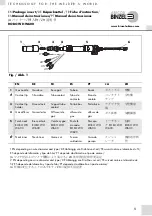
Publ. No. TM 614 006 699 Rev B – ENGLISH (EN) – Oct 30. 2008
17
Theory of thermal imaging
17.1
Introduction
The subjects of infrared radiation is still new to many who will use an
infrared camera. In this section the theory behind thermal imaging will
be given.
17.2
The electromagnetic spectrum
The electromagnetic spectrum is divided arbitrarily into a number of
wavelength regions, called bands, distinguished by the methods used to
produce and detect the radiation. There is no fundamental difference be-
tween radiation in the different bands of the electromagnetic spectrum.
They are all governed by the same laws and the only differences are those
due to differences in wavelength.
Figure 17.1 The electromagnetic spectrum 1: X-ray; 2: UV; 3: Visible; 4: IR; 5: Microwaves;
6: Radiowaves.
Thermal imaging makes use of the infrared spectral band. At the short-
wavelength end the boundary lies at the limit of visual perception, in the
deep red. At the long wavelength end it merges with the microwave radio
wavelengths, in the millimeter range.
1
2
3
4
5
6
10 nm
100 nm
1
µ
m
10
µ
m 100
µ
m
1 mm
10 mm
100 mm
1 m
10 m
100 m
1 km
2
µ
m
13
µ
m















































